Newton’s Second Law of Motion
Force is equal to the rate of change of momentum. For a constant mass, force equals mass times acceleration.
Defining Newton’s Second Law of Motion
Newton’s second law states that the acceleration of an object depends upon two factors – the net force acting on the object and the mass of the object. Theaccelerationof the body is directly proportional to the net force acting on the body and inversely proportional to the mass of the body. This means that as the force acting upon an object is increased, the acceleration of the object is increased. Likewise, as the mass of an object is increased, the acceleration of the object is decreased.
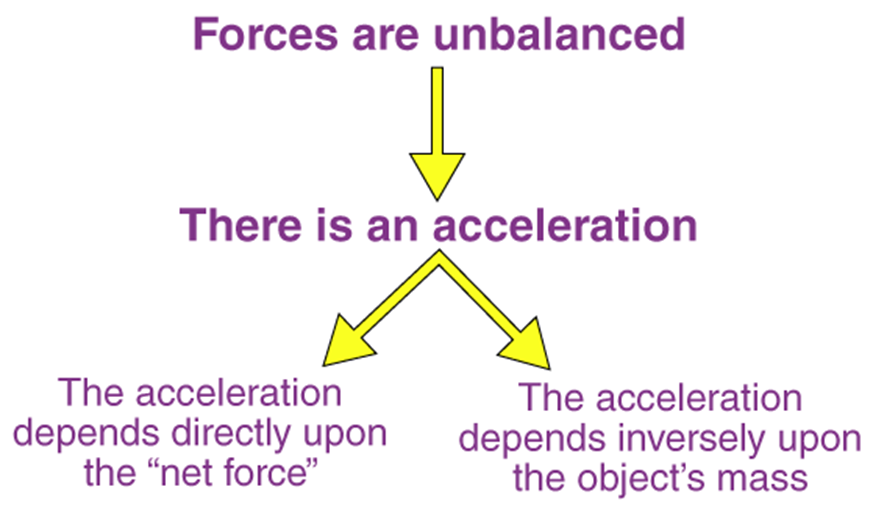
Newton’s second law can be formally stated as,
The acceleration of an object as produced by a net force is directly proportional to the magnitude of the net force, in the same direction as the net force, and inversely proportional to the mass of the object.
This statement is expressed in equation form as,
a =
The above equation can be rearranged to a familiar form as
F = ma
Since force is a vector, Newton’s second law can be written as
The equation shows that the direction of the total acceleration vector points in the same direction as the net force vector.
DERIVING NEWTON’S SECOND LAW
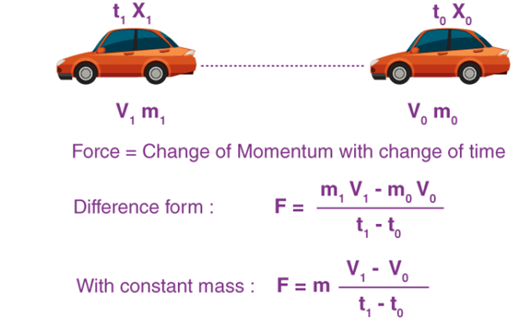
For Changing Mass
Suppose there is a car at a point (0) defined by location X0and time t0. The car mass m0and travels with a velocity v0. After apply to a force F, the car moves to point 1 which is defined by location X1and time t1. The mass and velocity of the car change during the travel to values m1and v1. Newton’s second law helps us determine the new values of m1and v1 if we know the value of applied force.
Taking the difference between point 1 and point 0, we get an equation for the force acting on the car as follows:
![]()
Assume the mass is constant. This assumption is good for a car because the only mass change would be the burning of fuel between points "1" and "0". The weight of the fuel is likely to remain small compared to the rest of the car, especially considering only small changes over time. But if we talked about the flight of a bottle rocket, the mass does not remain constant and we can only observe changes in momentum.
For Constant Mass
For a constant mass, Newton’s second law can be equated as follows:
![]()
We know that acceleration is defined as the change in velocity divided by the change in time.
The second law then reduces to a more familiar form as follows:
F= ma
The above equation tells us that an object will accelerate if it is subjected to an external force. The amount of force is directly proportional to the acceleration and inversely proportional to the object’s mass.
----------------------------------------------------------------------------------------------------------------
NET FORCE
The net force is defined as is the sum of all the forces acting on an object. Net force can accelerate a mass. Some other force acts on a body either at rest or motion. The net force is a term used in a system when there is a significant number of forces.
Formula of Net Force
If N is the number of forces acting on a body, the net force formula is given by,
FNet= F1+ F2+ F3….+ FN
Where,
F1, F2, F3…FNis the force acting on a body.
Net force when a body is at rest: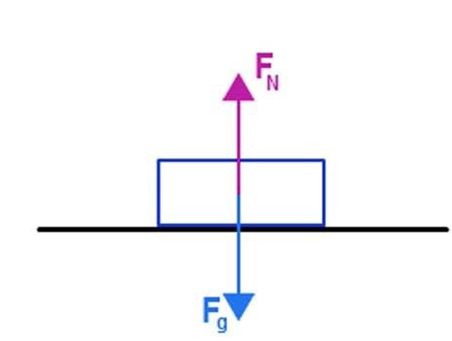
When the body is at rest, the net force formula is given by,
FNet= Fa+ Fg.
Where,
Fa= applied force,
Fg= gravitational force.
Net force when a body is in motion:
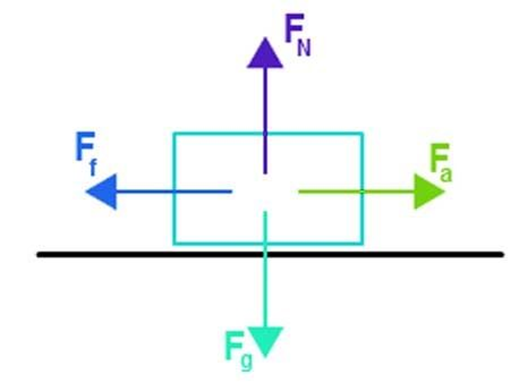
When a force is applied to the body, not only is the applied force acting, there are many other forces like gravitational force Fg, frictional force Ff and the normal force that balances the other force.
Therefore, the net force formula is given by,
FNet= Fa+ Fg+ Ff+ FN.
Where,
- Fais applied force,
- Fgis the gravitational force,
- Ffis the frictional force,
- FNis a normal force.
----------------------------------------------------------------------------------------------------------------
DERIVATION OF EQUATION OF MOTION
The equations of motion can be derived using the following methods:
- Derivation of equations of motion by Simple Algebraic Method
- Derivation of equations of Motion by Graphical Method
- Derivation of equations of Motion by Calculus Method
In the next few sections, the equations of motion are derived by all the three methods in a simple and easy to understand way.
DERIVATION OF SECOND EQUATION OF MOTION
For the derivation of the second equation of motion, consider the same variables that were used for derivation of the first equation of motion.
Derivation of Second Equation of Motion by Algebraic Method
Velocity is defined as the rate of change of displacement. This is mathematically represented as:
Velocity =
Rearranging, we get
Displacement = Velocity Time
If the velocity is not constant then in the above equation we can use average velocity in the place of velocity and rewrite the equation as follows:
![]()
Substituting the above equations with the notations used in the derivation of the first equation of motion, we get
s=
From the first equation of motion, we know thatv = u + at. Putting this value ofvin the above equation, we get
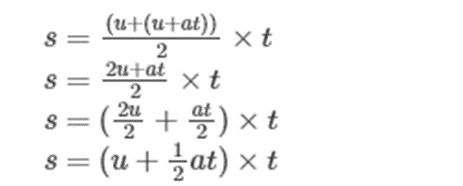
On further simplification, the equation becomes:
|
S = ut +at2 |
Derivation of Second Equation of Motion by Graphical Method
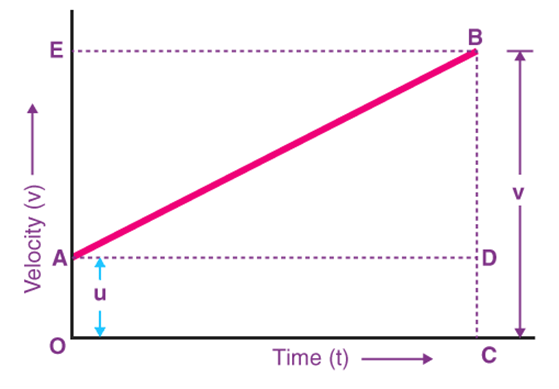
From the graph above, we can say that
Distance travelled (s) = Area of figure OABC = Area of rectangle OADC + Area of triangle ABD

On further simplification, the equation becomes
|
S = ut +at2 |
Derivation of Second Equation of Motion by Calculus Method
Velocity is the rate of change of displacement.
Mathematically, this is expressed as
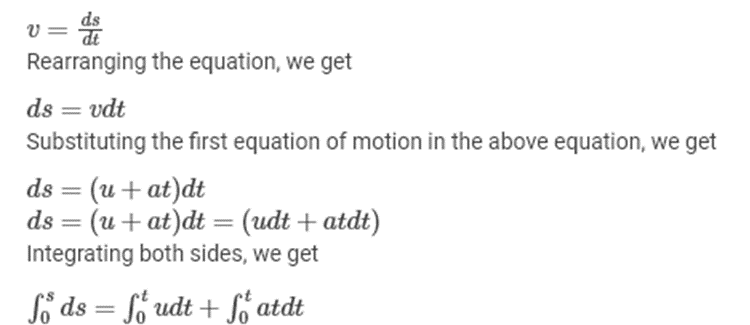
On further simplification, the equations becomes:
|
S = ut +at2 |
APPLICATION OF SECOND LAW
Newton's second law is used to determine the force required to move or stop an object. Here are some examples that we have listed so that you understand this point:
Kicking a ball
When we hit the ball, we apply a force in a certain direction. The harder we hit the ball, the more force we put on it and the further it travels.
Pushing a cart
An empty trolley is easier to push in a supermarket than a loaded one, and a larger mass requires more acceleration.
Two people walking
Between two people walking, if one is heavier than the other, the heavier person walks slower because the acceleration of the lighter person is greater.